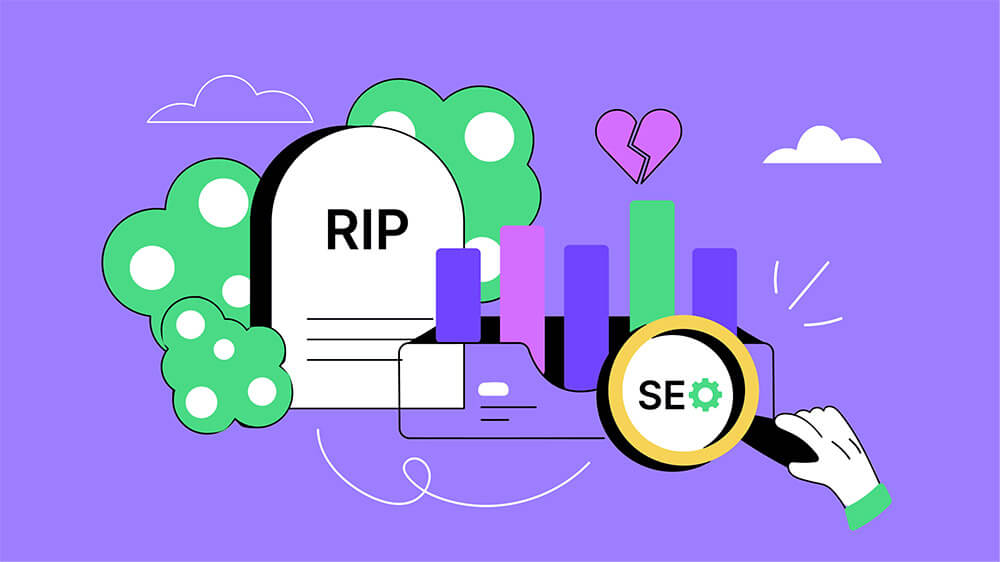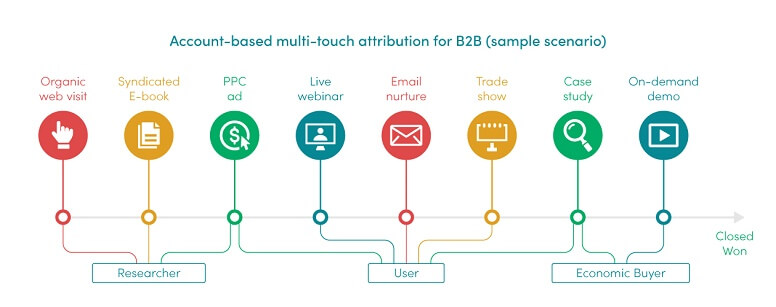Is SEO Dead? The Great Decoupling and the Future of Digital Visibility
 The reports of SEO's death have been greatly exaggerated—but traditional search traffic is undeniably declining. Here's what the data really tells us, and what businesses must do now.
The reports of SEO's death have been greatly exaggerated—but traditional search traffic is undeniably declining. Here's what the data really tells us, and what businesses must do now.
The question isn't whether SEO is dying. The question is whether you're still optimizing for a search landscape that no longer exists.
In 2025, we're witnessing what industry analysts have dubbed "the great decoupling"—the dramatic separation of search impressions from actual clicks. Websites rank on page one. Traffic declines anyway. Welcome to the zero-click era.
The 2025 Algorithm Transformation
Google's 2025 algorithm updates have significantly reshaped the digital landscape. The March core update rolled out on March 13th and completed two weeks later—the second major update of the year. Then came the June core update on June 30th, taking over two weeks to complete and causing widespread ranking volatility across news, health, finance, and shopping sectors.
The August spam update began August 26th, signaling Google's continued focus on content quality. Sites that had weathered previous updates found themselves facing new challenges.
These weren't gentle nudges. They were substantial shifts. Between May 1st and June 18th alone, tracking tools recorded at least nine separate periods of major ranking volatility—most of them undocumented by Google. The search giant confirmed only one official update while the entire ecosystem experienced significant changes.
The Traffic Decline: By the Numbers
The data tells a clear story:
General search referral traffic to tracked web domains dropped from 12 billion global visits in June 2024 to 11.2 billion in June 2025—a 6.7% year-over-year decline. This isn't a temporary fluctuation. It's a sustained trend.
News publishers experienced significant impacts. According to data tracking over 100 million keywords, zero-click searches for news-related queries surged from 56% to nearly 69% by May 2025. Organic search referral traffic to news sites declined from over 2.3 billion U.S. visits in July 2024 to 1.8 billion in June 2025.
Some specific casualties:
- CBS News: 75% of their top 100 search keywords that triggered AI Overviews resulted in zero clicks in May 2025, compared to 54% previously
- Mail Online: 56% decrease in click-through rate when AI Overviews appeared for their top-ranking keywords
- Position 1 rankings: Down 34.5% in CTR when AI Overviews are present
- Chegg (education company): 49% decline in non-subscriber traffic in January 2025 year-over-year
- Fashion, travel, DIY, and cooking sites: Some reporting up to 70% traffic drops
A lifestyle publisher shared data on the search query "how to get rid of [insect]." Despite ranking on page one with stable impressions, their CTR dropped from 5.1% to 0.6% over one year.
The primary driver of this shift? AI Overviews.
The AI Overview Takeover
Google's AI Overviews—those AI-generated summaries sitting at the top of search results—now appear in approximately 20% of U.S. desktop searches. That number has plateaued, but the damage is done. When users see an AI Overview, Pew Research found they're half as likely to click any link. They're also more likely to end their browsing session entirely.
Let that sink in: Google is training users not to visit websites.
The impact varies by industry. Science, Health, People & Society, and Law & Government categories have seen the largest share growth of AI Overviews—with Science up 22.27%, Health up 20.33%, and People & Society up 18.83%. These information-dense, high-trust categories are being systematically stripped of their traffic.
BrightEdge reports that AI Overviews now appear in over 35% of all U.S. Google desktop searches and are trending higher on mobile. These AI summaries can occupy up to 800 pixels on the search results page—pushing organic results into oblivion.
The Zero-Click Future
Here's the uncomfortable truth: 65% of Google searches now end without a click. On mobile devices, that number rises to 75%.
Even when AI Overviews include citations and links, users aren't clicking. They're getting their answers and leaving. Google calls these "higher quality clicks" when they do happen—meaning users stick around longer on the site. But fewer visitors spending more time each doesn't offset the sheer volume lost.
The Digital Content Next survey of publisher members revealed that between May and June 2025, the median year-over-year decline in referral traffic from Google Search was 10% overall, 7% for news brands, and 14% for non-news brands. Over two-thirds of publishers reported losses between 1% and 25%.
Meanwhile, AI search platforms like ChatGPT and Perplexity—often cited as the future—still drive less than 1% of traffic to most sites. They're not offsetting anything. The traffic isn't going elsewhere. It's just gone.
The Shift Toward AI-First Search
This is the phenomenon reshaping digital marketing: impressions remain stable or even increase, while clicks decline. You're ranking. You're visible. The algorithm recognizes your content. Users see you.
They just don't need to visit you anymore.
This decoupling represents a fundamental shift in how search functions. For decades, search engines were gateways—connecting information seekers to information sources. Now they're destinations—extracting value from your content and keeping users within their own ecosystem.
Google is becoming the world's largest content aggregator, synthesizing expertise into summaries while maintaining users within its ecosystem.
Higher-Intent Clicks and Multi-Touch Journeys
There's a silver lining, albeit a thin one: the clicks that do happen carry more weight.
Today's consumer journey is increasingly complex and non-linear. Research shows consumers typically engage with brands 3+ times across digital channels before purchase. For high-earning consumers ($250k+ household income), that number jumps to 5+ touchpoints.
This creates what Microsoft Advertising calls the shift "from clicks to conversations"—where generative AI is shortening the customer journey, compressing touchpoints, and raising expectations at every stage. Search has transformed from static queries into fluid conversations, helping users refine, follow up, and explore naturally.
The implication? When someone does click through from search, they're further along their decision journey. They have higher intent. They're more qualified. They convert at higher rates.
Some data supports this: certain YMYL (Your Money, Your Life) clients report experiencing a loss in impressions but an increase in clicks, signaling that algorithm updates filter out irrelevant traffic while directing relevant, high-intent traffic to authoritative sources.
The challenge is that multi-touch attribution has become exponentially more complex. Users blend voice, images, chat, and text in their search journeys. According to eMarketer, 46% of Gen Z and 35% of millennials now prefer social platforms to traditional search engines. The path to conversion now spans platforms, devices, and formats—making it nearly impossible to track ROI using traditional metrics.
 So Is SEO Actually Dead?
So Is SEO Actually Dead?
No. But it's evolving rapidly.
The discipline formerly known as search engine optimization must evolve into something broader: digital visibility optimization. Here's what that means in practice:
1. Optimize for AI Extraction, Not Just Rankings
Your content will be summarized whether you like it or not. Make it easy to extract correctly:
- Use clear headings (H1, H2, H3) with descriptive, question-based titles
- Structure content with bullet points, tables, and FAQ sections
- Provide concise, definitive answers in the first 50-100 words
- Use schema markup extensively to help AI understand context
- Create content that can be parsed and synthesized without losing meaning
The goal isn't to prevent AI extraction—that's impossible. The goal is to ensure your brand is cited, your expertise is acknowledged, and your name becomes associated with the topic.
2. Double Down on E-E-A-T
Experience, Expertise, Authoritativeness, and Trust aren't buzzwords—they're survival requirements. Google's algorithms increasingly reward:
- Real credentials from real authors
- Firsthand knowledge and original research
- Authoritative citations to primary sources
- Demonstrated subject matter expertise
- Transparent authorship and organizational credentials
Create depth, not breadth. One comprehensive, authoritative piece beats ten shallow ones. Sites with stronger SEO foundations and higher ongoing investment proved more resilient to 2025's updates.
3. Build Direct Relationships
If Google is training users not to visit websites, you must train your audience to come directly:
- Email marketing becomes non-negotiable. Build your list aggressively.
- Newsletters that provide value beyond what AI summaries offer
- Subscriptions and memberships for premium content
- Social media followings as owned distribution channels
- Podcasts and video content that create deeper engagement
- Brand building so people search for you by name
The Verge's response to traffic losses? Doubling down on subscriptions, pushing podcasts and newsletters, and making their website more social—allowing readers to follow writers and topics. When your brand is strong enough, people bypass Google entirely.
4. Embrace Zero-Click Strategy
Stop measuring success purely by traffic. Start thinking about:
- Brand visibility in AI summaries and featured snippets
- Share of voice in your category
- Citation frequency in AI-generated content
- Brand recall and awareness metrics
- Conversion rate from the traffic you do get
If 65% of searches end without clicks, optimizing for zero-click visibility isn't surrender—it's pragmatism. Your content should be valuable enough that appearing in the answer itself still builds brand equity.
5. Diversify Traffic Sources Aggressively
Google dependency is now an existential risk. Build parallel channels:
- Direct traffic through brand building and type-in visits
- Social media as primary distribution (especially TikTok, Instagram, LinkedIn depending on audience)
- Partnerships and collaborations for cross-promotion
- Paid advertising to control your own traffic destiny
- Community building through forums, Discord, Slack groups
- Traditional media that drives brand awareness
The goal: ensure Google represents less than 40% of your total traffic. If it's higher, you're vulnerable.
6. Technical Excellence Is Table Stakes
With volatility this high, technical SEO cannot be neglected:
- Mobile-first indexing means mobile speed and UX are non-negotiable
- Core Web Vitals (Largest Contentful Paint, First Input Delay, Cumulative Layout Shift) must be optimized
- Schema markup for all content types
- Clean site architecture with logical hierarchies
- Fast page speeds (aim for under 2 seconds)
- Crawlability without errors or orphaned pages
Sites with strong Core Web Vitals held steady during 2025's updates. Slow or unresponsive pages dropped as bounce rate signals increased in importance.
7. Create for Humans, Optimize for Machines
The pendulum has swung back toward quality. Google's spam updates specifically target:
- Thin content with low value
- Keyword-stuffed, over-optimized pages
- Manipulative link schemes
- Scraped or recycled content
- AI-generated spam at scale
The irony? Google is using AI to punish sites for using AI poorly. The winning formula:
- Write for your actual audience first
- Use AI as a research and editing tool, not a content creator
- Add unique insights, original data, and expert perspective
- Go deeper than your competitors
- Update content regularly to maintain freshness
8. Monitor, Measure, Adapt
In an environment this volatile, ignorance is death:
- Google Search Console for impressions, clicks, and position tracking
- Analytics to understand actual user behavior (not just traffic volume)
- Rank tracking tools to monitor SERP changes
- Competitor analysis to separate site issues from ecosystem shifts
- Algorithm update calendars to annotate when changes occur
Don't react to every fluctuation—algorithm updates take weeks to settle. But do identify consistent patterns. If you're losing traffic across entire categories or query types, that's signal, not noise.
The Current Reality
Let's be clear about what's happening: Google is changing how it connects users to information. The company built its empire by linking users to websites. Now it's evolving toward keeping users within its own ecosystem for more queries.
This isn't a conspiracy. It's a business evolution. Google's AI Overviews generate new advertising revenue while changing the value proposition for publishers. The company still sends billions of clicks to websites daily—but that's declining in both absolute terms and as a percentage of total searches.
For businesses heavily dependent on organic search, this represents a significant challenge. The travel blog The Planet D closed after traffic dropped 90% following AI Overviews' introduction. It won't be the last.
What Success Looks Like Now
Success in 2025 and beyond won't look like traditional SEO wins. It will look like:
- A diversified traffic portfolio where no single source represents more than 40%
- Higher conversion rates from lower traffic volumes
- Strong brand recognition that drives direct visits
- Content that gets cited in AI summaries even when clicks decline
- Audience relationships that transcend search algorithms
- Revenue models that don't depend solely on pageview-based advertising
- Subscription and membership revenue offsetting ad losses
- Product and service offerings with better margins than ad revenue
The days of building a business purely on SEO traffic are over. SEO is now one channel among many—and an increasingly unreliable one at that.
The Path Forward
SEO isn't dead. But the SEO landscape is transforming, and something new is emerging in its place.
The businesses that will thrive are those that:
- Accept the new reality and adapt accordingly
- Move strategically to diversify beyond Google dependency
- Build genuine expertise and authority in their niches
- Create direct relationships with their audiences
- Optimize for visibility across all forms—including AI summaries
- Focus on conversion and customer value over vanity metrics
This transition requires adjustment. Change always does. But adaptation is more productive than resistance.
The great decoupling is happening whether we like it or not. The question isn't whether SEO is dead. The question is whether your strategy aligns with the current digital landscape.
The answer to that question will determine your competitive position moving forward.
The data is clear. The trend is undeniable. The only question left is: what are you going to do about it?

 So Is SEO Actually Dead?
So Is SEO Actually Dead?